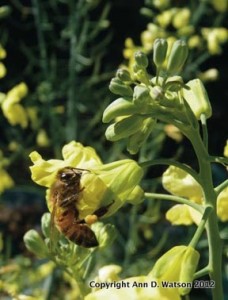Let Your Broccoli Flower!

It’s happened to us all: You go away for a few days, or it rains, or you get busy with other things and before you know it that head of broccoli in the garden is flowering. But wait – Did you know that broccoli and other members of its family are favorites of honeybees?
Bees love the flowers from the brassicaceae or cruciferous vegetable family, which includes cauliflower, cabbage, cress, broccoli, brussels sprouts, kale, radishes, mustard, turnip, horseradish, and much more. It is thought that, as with humans, variety in honeybee diets is crucial to their health. By providing many different kinds of flowers for bees to forage on, you are helping them to be healthier. More information on the brassica family can be found at organicsforall.org. Information about how you can help the bees can be found at the University of Minnesota Bee Lab.
If you’ve accidentally missed a few broccoli heads and they go to flower, the good news is that their nectar and pollen will feed the bees. In turn, the bees will pollinate the flowers, enabling the seeds to develop. Later in the fall you can collect the seeds, and next spring you can plant extra for the pollinators.
Annie Watson
